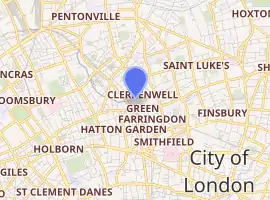15 Clerkenwell Close
15 Clerkenwell Close is a building in London designed by architect Amin Taha, completed in 2017. The building's stone facade was controversial when it appeared, as it had not been fully detailed in the building's planning documents. Islington Council called for the building's demolition, but this was overturned on appeal. The building won a RIBA National Award in 2018.
| 15 Clerkenwell Close | |
|---|---|
.jpg.webp) | |

| |
| General information | |
| Type | Mixed-use |
| Completed | 2017 |
| Cost | £4.4 million |
History
Taha originally proposed a building with a bronze facade in 2012. Taha then replaced this design with one utilizing bricks before settling on stone. During construction, Islington council indicated that the brick facade was the chosen one on its website, apparently due to an error.[1] The council had received and approved designs for the stone facade, but because they were never placed online for the public to see, the final facade was a surprise to neighbours.[2] Islington Council issued a ruling that the building be demolished in mid-2017 due to the error,[2] which the council withdrew after an inquiry from a legal team employed by Taha. After rescinding the first order to demolish the structure, the council issued a second in February 2018, following "an investigation" that determined the building's final design differed from the approved design. This order cited the location of the fossils within the stone facade as "[...] deleterious to the conservation area and listed buildings" due to their "haphazard" placement.[2]
In August 2019, Taha's appeal was successful and the council's planning office granted planning permission, ruling that the building "accords with the generality of what had previously been approved" and removing the demolition order.[3]
Taha lives on the top floor of the building with his family,[4] and the building houses the offices of his architectural practice Amin Taha + Groupwork.[2]
Design
The building has a limestone facade, with visible fossils embedded in the material.[5] The limestone was sourced from Normandy, and acts as a supportive "exoskeleton" for the building, meaning the interior does not require columns or other supports.[5] Use of limestone sourced from Normandy was inspired by the site's original structure, an 11th-century Norman abbey, also built from limestone, unusual for that time.[6] The building includes a small public park to its left.
Taha cites Alvar Aalto, Carlo Scarpa and Ludwig Mies van der Rohe as inspirations for the structure.[5]
Reception
Ann Pembroke, of the Clerkenwell Green Preservation Society, said she was "appalled" by its aesthetic departure from the surrounding buildings, adding that "If you want to do something outrageous don't choose a medieval close to put it in."[4]
The building won a RIBA National Award, and was also considered for the Carbuncle Cup.[2]
In contrast to the mixed feedback Taha received for 15 Clerkenwell, his firm's 168 Upper Street, also in Islington, was approved by the borough's planning committee.[7]
References
- Heathcote, Edwin (1 December 2018). "Amin Taha's London experiment in stone faces demolition". The Financial Times. Retrieved 11 April 2019.
- Ravenscroft, Tom (26 September 2018). "Amin Taha ordered to demolish his RIBA Award-winning home and office 15 Clerkenwell Close". Dezeen. Retrieved 11 April 2019.
- Crook, Lizzie (15 August 2019). ""The battle is over" says Amin Taha as 15 Clerkenwell Close is saved from demolition". Dezeen. Retrieved 16 August 2019.
- "Clerkenwell architect clashes with Islington Council while critics hail his "architectural triumph"". Camden New Journal. 21 September 2018. Retrieved 19 August 2019.
- Lutyens, Dominic (10 January 2019). "Amin Taha: London's most controversial architect". The Financial Times. Retrieved 11 April 2019.
- "Clerkenwell architect clashes with Islington Council while critics hail his "architectural triumph"". CamdenNewJournal. 21 September 2018. Retrieved 11 April 2019.
- Aldous, Simon (19 January 2019). "Weekend roundup: Building the slums of the future". Architects' Journal. Retrieved 11 April 2019.